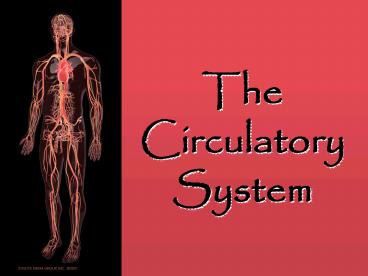The Circulatory System PowerPoint PPT Presentation
1 / 23
Title: The Circulatory System
1
The Circulatory System
2
Idea that blood circulates in the body dates back
to the 1620s and English physician William
HarveyBlood vessels form closed delivery
system that begins and ends with the heart
transporting blood 60,000 miles (the Earth has a
circumference of 24,902 miles) Includes
50,000,000,000 capillaries
3
Functions of the Peripheral Circulatory System
- Carries blood from heart to tissues to heart
- Exchange nutrients, waste products and gases
w/tissues - Transports substances (hormones, components of
immune system, coag. Agents, NZs, nutrients,
gases, waste products, etc. - Helps regulate blood pressure
- Directs blood flow to tissues when required to
maintain homeostasis
4
Vessels In Sequence
- ELASTIC ARTERIES
- MUSCULAR ARTERIES
- ARTERIOLES
- CAPILLARIES
- VENULES
- SMALL VEINS
- MEDIUM/LARGE VEINS
5
(No Transcript)
6
General Features of Blood Vessels
7
(No Transcript)
8
Tunics- the details
- Tunica Intima
- innermost layer smooth surface of endothelium
enables ease of blood flow - Tunica Media
- middle layer of smooth muscle cells arranged
circularly with variable amounts elastic and
collagen fibers elastic connective tissue in
muscular arteries - Tunica Externa or Adventitia
- outer layer of connective tissue
9
Action of Smooth Muscle
- Long, narrow, tapered muscle cells arranged
circularly that contract and relax slowly so not
to affect heart action but control size of blood
vessel lumen - Vasoconstriction- narrows lumen
- Vasodilation- enlarges lumen
- WHY?
10
Specialized Features of Blood Vessels
- Arteries- conduct blood under high pressure have
thick strong walls - a. elastic arteries-
- b. muscular arteries-
- c. arterioles-
11
- 2. Capillaries- allow greater surface area and
slows speed of blood so exchange can take place
12
(No Transcript)
13
- 3. Veins- return blood to heart under low
pressure
14
(No Transcript)
15
- YouTube - Mechanism of Vein
16
Physiology of Circulation
- Pulse- wave of pressure that begins in the
ventricles and travels through the arteries - PULSE RATE HEART RATE
- Can be measured in any artery close to body
surface compress artery against firm tissue
17
(No Transcript)
18
- Assess
- Rate
- Regularity
- Strength
- Normal- 70-76 bpm in resting person
- Factors Influencing Pulse-
- activity
- postural changes
- emotions
19
Blood Pressure
- The pressure the blood exerts against the inner
walls of blood vessels - It is the force that keeps the blood circulating
between heartbeats
20
- In other words
21
- Any system equipped with a pump that forces fluid
through a network of closed tubes operates under
pressure. - The closer you get to the pump, the higher the
pressure. - Blood pressure understood to mean the pressure
within the large systemic arteries near the heart
22
Principles that determine pressure and flow
include
- The heart-
- Size of the vessel-
- Speed vs. Pressure-
- Constriction-
23
- YouTube - Blood Pressure

